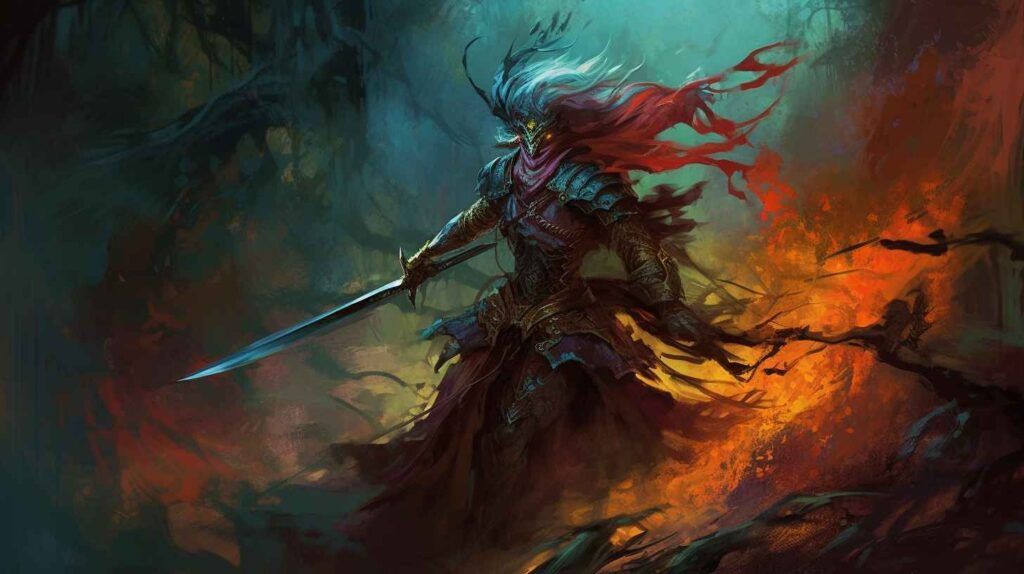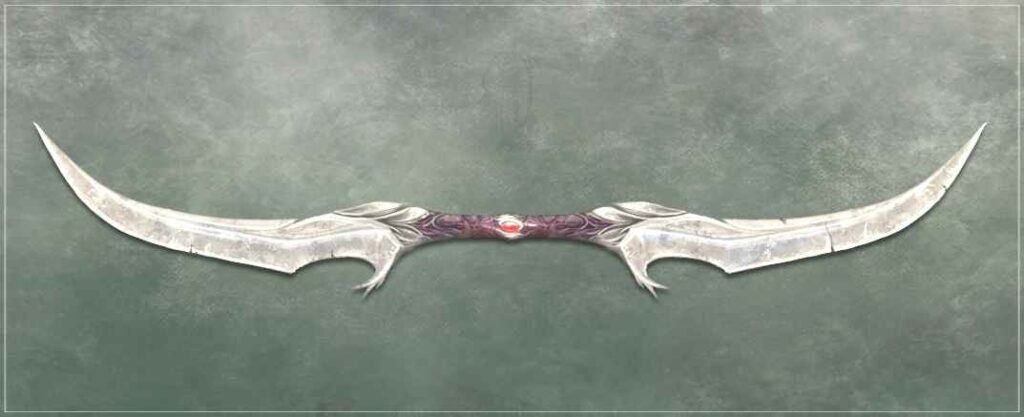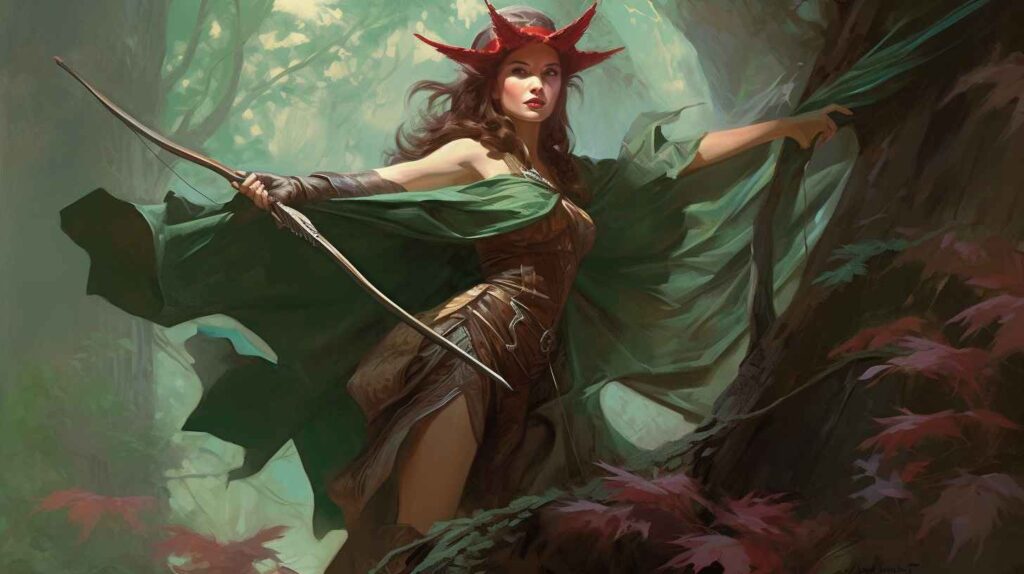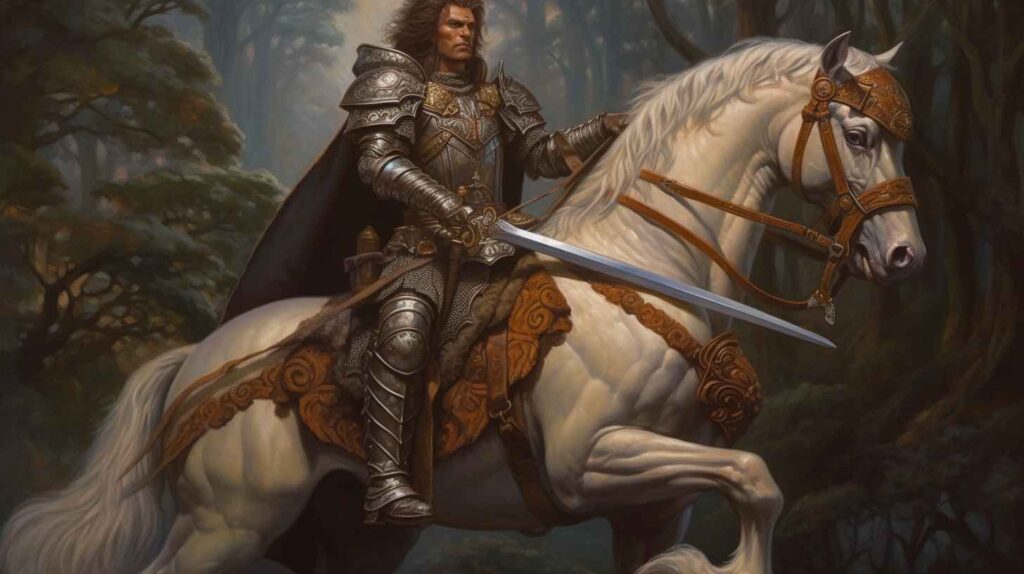At first glance, you might not think much of scimitars. After all, their curved shape may seem unremarkable or even mundane. However, when it comes to finding a swift and stylish weapon for your D&D character, the scimitar should be your top choice. As avid players ourselves, we have seen countless characters wield scimitars, and we can confidently say that it is one of the most effective and visually appealing weapons available.
When evaluating different weapons, there are several important metrics to consider. Let’s delve into why the scimitar excels in these areas and why it deserves your attention.
| Attribute | Data |
|---|---|
| Category | Items |
| Damage | 1d6 |
| Damage Type | Slashing |
| Item Rarity | Standard |
| Properties | Finesse, Light |
| Weight | 3 |
Scimitar: A Versatile Weapon for Dexterity-based Characters

The scimitar is a martial close-combat weapon known for its cutting prowess, dealing 1d6 damage with each strike. Its exceptional fineness and lightness make it an ideal choice for dexterity-based characters, particularly those who favor the use of two weapons simultaneously. Weighing a mere 3lb, the scimitar offers agility without compromising on effectiveness. However, with a price tag of 25gp, it falls on the higher end of the spectrum for single-handed weapons.
Description: Curved Swords with Unique Design
As a type of backsword, the scimitar stands out with its distinctive features. It is a single-bladed sword designed to be wielded with a single hand. What sets it apart is its curved blade, providing excellent cutting capabilities while sacrificing effectiveness in pushing attacks. The non-blade side of the sword is intentionally thicker, enhancing its strength and stability during combat. The end of the scimitar often exhibits a wider and flatter shape, adding weight to the swing and maximizing slicing efficiency. Compared to other weapons, the scimitar remains relatively lightweight.
Precision Strikes and Strategic Advantages
While some blades rely on sheer force to inflict damage, the scimitar compensates for its lighter weight by excelling in targeted strikes. Its design is optimized for attacking weak spots in armor and crucial areas of the body. This precision-focused approach enhances the scimitar’s effectiveness, allowing skilled wielders to bypass defenses and deliver impactful blows.

Special Properties
Scimitars possess distinct qualities that deserve your attention when wielding them in combat. Let’s explore these special properties and how they can greatly impact your gameplay:
- Finesse: Precision and Dexterity: Finesse stands out as one of the most crucial properties for fighters relying on dexterity. It grants wielders the flexibility to utilize their dexterity modifier instead of their strength modifier when making attack and damage rolls. This choice is optional, as they can still opt to use their strength if desired. However, it’s important to note that they must consistently use the same modifier for both rolls. While rangers and rogues commonly favor finesse weapons, any character with considerable dexterity can benefit greatly from their usage.
- Light: Dual-Wielding Advantage: Light weapons offer a unique advantage, as they can be effectively wielded by two individuals simultaneously. If you possess a melee weapon in each hand and both of them are classified as light, you have the opportunity to make two attacks during your turn. By utilizing your action to attack with your main hand and a bonus action to attack with your off-hand, you can maximize your combat potential.
- Taking on the Challenge: To overcome the restrictions imposed by this rule, you can consider the Dual Wielder feat, which permits you to dual-wield weapons that aren’t classified as light. If your strength surpasses your dexterity, this feat becomes particularly enticing, granting you the ability to wield two battleaxes simultaneously. However, for those who prioritize nimbleness over sheer strength, rapiers emerge as a superior choice. While the idea of wielding two rapiers simultaneously may sound appealing, it’s worth noting that it requires investing an entire feat. Interestingly, without this feat, wielding two scimitars proves to be one of the most effective methods of inflicting damage with a finesse weapon.
Double-Bladed Scimitars: Uncommon Yet Intriguing

A less commonly seen variant of the standard scimitar, the double-bladed scimitar offers a unique appeal. While the Valenar elves are renowned for their proficiency with this weapon, anyone with a desire to channel their inner Darth Maul can wield it as well. As the name suggests, it consists of two scimitars fused together, resulting in a weight that is twice that of a regular scimitar, totaling 6lb. However, the price of this distinctive weapon is significantly steeper, amounting to a hefty 100gp. Acquiring one may prove to be a challenge, as their rarity often leads to potential duels if you’re caught in possession of one. Valenar elves, in particular, tend to question non-elves who wield the double-bladed scimitar, suspecting them of being thieves who are undeserving of such a weapon.
The double-bladed scimitar allows for attacks resembling those made with two weapons.
While these aspects contribute to its intriguing flavor and history, the practicality of the double-bladed scimitar as a weapon falls somewhat short. It can be regarded as a matter of personal preference rather than a superior choice. Comparatively, it lacks the sharpness and lightness of a regular scimitar, requiring the use of both hands. Its slashing damage is also modest, amounting to 2d4. In essence, the weapon’s performance is not significantly superior to using two separate scimitars. However, the double-bladed scimitar allows for attacks resembling those made with two weapons. When included as part of your attack action, using a double-bladed scimitar permits an immediate bonus action for another melee attack. Nonetheless, the damage for the second attack is reduced to 1d4 slashes, resulting in minimal variance in overall damage when compared to wielding two scimitars. In either scenario, the maximum damage potential remains at 12, with an average damage output of 6.
Notably, the double-bladed scimitar possesses a unique attribute exclusive to itself. This special ability, known as “Revenant Blade,” distinguishes it from other weapons within the game. While initially intriguing, it presents a drawback: this feat does not provide any advantages that cannot be obtained through the use of two scimitars and other feats, as we will explore further in our discussion.
Classes that Can Use the Scimitar
While any class can wield a scimitar by taking the Weapon Master feat, there are certain classes that naturally shine when utilizing this weapon. Let’s explore these classes and how their abilities synergize with the scimitar:
Fighter: Ideal for Scimitar Use

Scimitars are excellent weapons for fighters, particularly those with a good dexterity modifier. With increased attack and damage rolls, fighters wielding scimitars can also dual-wield if necessary. Medium or light armor further enhances their AC, and adding a shield provides additional protection on the front lines. The Dueling and Two-Weapon Fighting options from the Fighting Style feature greatly benefit this type of fighter build. However, those who prefer shields and single weapons may find the rapier more suitable, as it offers higher damage output. Alternatively, if strength is prioritized, weapons like the longsword, battleaxe, or warhammer will prove more effective.
Ranger: Natural Affinity with Scimitars

The scimitar is often associated with rangers, who are commonly depicted with a bow on their back and a sword in each hand. Investing in dexterity is a wise choice for rangers, as it improves their AC and enhances abilities such as Hide In Plain Sight and Vanish. Since dexterity also benefits bow attacks, it pairs well with a close-quarters weapon that relies on the same attribute. Similar to fighters, rangers gain access to the Dueling and Two-Weapon Fighting options through the Fighting Style feature, providing additional versatility for scimitar users.
Barbarian: Unconventional but Possible

Although not the most optimal choice, barbarians can still wield scimitars effectively, especially if they wish to dual-wield weapons. While focusing on dexterity might not fully maximize their Rage ability, which heavily relies on strength, it is still possible to create a barbarian proficient with scimitars. The Danger Sense feature provides a bonus to dexterity saving throws, while Unarmed Defense combines dexterity and constitution modifiers for improved Armor Class (AC). Since most barbarians eschew shields, those who prefer a single weapon can opt for a two-handed weapon instead.
Paladin: Unique Build Potential

Paladins do not necessarily require high dexterity, as they can wear heavy armor, and bludgeoning damage is particularly effective against undead, which are often their adversaries. The focus of their spellcasting on shields provides an incentive to use a single weapon rather than dual-wielding. While specializing in scimitars may not be the most optimal choice for paladins, it presents a unique and memorable character build. The Fighting Style feature offers the “Dueling” and “Two-Weapon Fighting” options, which can greatly benefit those wielding scimitars.
Druid: Unexpected Aptitude
Despite druids’ aversion to metal, they can still wield scimitars proficiently. While this proficiency is specific to scimitars and not a general martial skill, it remains their sole option for this type of weapon. Druids often invest in dexterity to enhance their AC and require a free hand for spellcasting, making scimitars more useful for them than for other classes. Although druids typically prefer transforming into more suitable forms for close combat, having a scimitar as a backup weapon proves valuable in case the need arises.
Wizard (Bladesinger): Selective Access

While most wizards are limited to simple weapons, the Bladesinger subclass breaks this restriction. Through their Training in War and Song subclass feature, Bladesingers can effectively wield a one-handed melee weapon, making the scimitar a favorable choice. Bladesingers typically prioritize dexterity over strength and are unable to use shields without sacrificing the benefits of their Bladesong ability. This inclination often tempts them to dual-wield weapons.
Cleric (War/Tempest/Twilight Domain): Selective Exceptions

Clerics usually have access to simple weapons, excluding the scimitar. However, at level 1, the War, Tempest, and Twilight domains grant bonus skills, including proficiency with martial weapons. In contrast, the heavy armor provided by other domains may reduce the need to heavily invest in dexterity. Although scimitars hold a special place for scimitar enthusiasts, it may be more advantageous for clerics to prioritize shields and single-handed strength-based weapons like warhammers. Alternatively, some clerics may forego shields in favor of two-handed weapons like mauls.
Suggested Feats for Scimitars
When it comes to maximizing the potential of scimitars, there are several feats that work exceptionally well. Here are a few noteworthy options:
Slasher: Impede and Debilitate
The Slasher feat proves beneficial for any weapon that deals slashing damage. It grants the ability to slow down a target by 10 feet until the beginning of your next turn upon successfully hitting them. Furthermore, critical hits against you impose a significant penalty, inflicting disadvantage on the target’s attack rolls and hindering their movement.
Fighting Initiate (Dueling/Two-Weapon Fighting): Versatile Maneuvers
Fighting Initiate is a versatile feat that offers numerous options for a wide range of weapons. Depending on your scimitar usage, two specific options can prove valuable. If you exclusively wield a scimitar without any other weapons, Dueling provides a +2 bonus to your damage rolls. On the other hand, if dual-wielding scimitars is your preference, Two-Weapon Fighting allows you to add your ability modifier to the damage dealt by your offhand attack.
Dual Wielder: Enhanced Dual-Wielding
Consider the Dual Wielder feat if you already possess Two-Weapon Fighting from the Fighting Initiate feat. This feat simplifies the use of two different melee weapons simultaneously by providing a +1 bonus to your Armor Class (AC) when dual-wielding. Additionally, you can draw two one-handed weapons in a single turn, eliminating the need to wait multiple turns to be fully armed. It’s worth noting that this feat enables the use of one-handed weapons without the light property, expanding your options beyond scimitars. For example, a fighter with high dexterity might opt for two rapiers, increasing damage from 1d6 slashing to 1d8 piercing.
Defensive Duelist: Agile Defense
If you possess finesse weapons proficiency, the Defensive Duelist feat allows you to use your reaction to add your proficiency bonus to your AC when targeted by an attack from a creature wielding a finesse weapon. This defensive maneuver can potentially transform a powerful hit into a complete miss, making it an appealing choice for individuals with limited hit points. However, keep in mind that using this feat consumes your reaction, so it may be prudent to consider other options if you have alternative uses for your reaction. A dexterity score of 13 or higher is required to obtain this feat, which shouldn’t pose a challenge for those already utilizing finesse weapons.
Revenant Blade (Elf Only): Elven Mastery
Exclusive to pure-blooded elves and applicable only to the double-bladed scimitar, the Revenant Blade feat offers unique advantages. It grants the finesse property to the double-bladed scimitar and provides a +1 bonus to your AC while wielding it. While some may draw parallels to the Dual Wielder feat, it is worth noting that the Revenant Blade feat offers an additional advantage by providing a free ability point that can be allocated to either strength or dexterity, sweetening the deal. Furthermore, the Dual Wielder feat does not benefit those who wield double-bladed scimitars, making the Revenant Blade feat the preferred choice for elves wishing to wield this distinctive weapon.
Famous Scimitars: Icons of Craftsmanship and Power

Not all scimitars are created equal. While some are ordinary blades acquired through local blacksmiths, others stand as shining examples of exquisite craftsmanship and legendary status. Here are a few renowned scimitars that have garnered widespread acclaim:
- Ashram: The Eternal Flame: Forged by the followers of Anhur, this +2 scimitar is crafted from bronze. Adorned with a gem embedded in its hilt, emanating an eternal flame, Ashram carries an air of mystique. While it may seem as if a fire elemental resides within the gem, it actually houses a mysterious spirit. This enigmatic presence grants the sword remarkable durability, allowing it to withstand blows that would shatter lesser blades. Additionally, Ashram inflicts extra fire damage upon its targets. Its protective enchantments extend to the wielder, granting immunity to fire, thunder, and lightning.
- Twinkle & Icingdeath: Drizzt’s Dual-Wielding Scimitars: Drizzt Do’Urden, the famed drow of Dungeons & Dragons, is renowned for his mastery of dual-wielding weapons. In his hands, Twinkle and Icingdeath, two formidable scimitars, achieved legendary status. Twinkle, held in his left hand, boasts a blue sapphire star on its hilt that glows when danger approaches. It possesses a unique empathic bond with its wielder, allowing it to sense their emotions and communicate non-verbally. Primarily used defensively, Twinkle excels at deflecting attacks, providing Drizzt with openings to strike his foes.
- Icingdeath, held in Drizzt’s right hand, serves as his primary offensive weapon. Crafted from black adamantite, its hilt bears the likeness of a cat’s head. Its silver blade, with a diamond-shaped edge, is a frostbrand weapon specifically designed for combat against flame elementals and fire-based creatures. In accordance with its purpose, Icingdeath possesses the ability to absorb fire, safeguarding its wielder against fire damage, while delivering cold damage to adversaries. This combination makes it a formidable weapon against creatures reliant on heat.
- The Silver Scimitar Of Amahl the Mad: Mastery from Afar: Amahl Shoon IV, the Qysar of the Shoon Imperium, wielded this silver-plated scimitar. However, what made it truly extraordinary was Amahl’s ability to control it remotely. Through his mastery, the scimitar transformed into a dancing sword, allowing it to move independently through the air, slashing enemies while its owner remained at a safe distance. This style of combat suited Amahl, particularly as his swordsmanship skills were not his greatest strength, a fact that became even more pronounced as his sanity deteriorated.
- The Hornblades Of Mielikki: Gifts of the Forest Queen: While Silvanus, the Supreme Ranger, favored a massive hammer, his daughter Mielikki held a particular fondness for a pair of scimitars known as the Hornblades. At first glance, they appear as fragments of animal horns. However, when a concealed mechanism is activated, curved blades spring forth from the top, locking into place and transforming them into powerful +5 scimitars. Clerics and druids devoted to Mielikki often wield scimitars as a means of honoring and remembering the Hornblades. Rangers and fighters who embraced Mielikki’s teachings occasionally found themselves blessed with these remarkable blades, bestowed upon those who fought alongside the Forest Queen.
Similar Weapons: Alternatives to Consider
While scimitars hold their own unique appeal, there are several other weapons that offer similar functionality and versatility. Here are notable alternatives worth considering:
Shortsword: Closest Kin
If you’re seeking a weapon closely resembling a scimitar, the shortsword is your best bet. It deals piercing damage instead of slashing, weighs 2 pounds less, and comes at a lower cost of 10 gold pieces. For rogues, the shortsword proves advantageous as they possess proficiency with it, unlike scimitars.
For rogues, the shortsword proves advantageous as they possess proficiency with it, unlike scimitars.
Rapier: Finesse and Precision
Rapiers, favored by rogues as well, present an excellent alternative to scimitars. With a higher damage output of 1d8 piercing, rapiers share the coveted “finesse” property, allowing wielders to utilize their dexterity for attack and damage rolls. However, rapiers lack the “light” property, requiring the Dual Wielder feat if you intend to wield them with two hands.
Handaxe: Underestimated Power
Often overlooked, the simple handaxe offers a compelling alternative to the scimitar, particularly for builds not reliant on dexterity. Dealing the same damage (1d6 slashing) as a scimitar, handaxes are simple, light, and possess the added benefit of being throwable. The only notable distinction is the absence of the finesse property, limiting its use to individuals with considerable strength.
Dagger: Versatile and Agile
While daggers may not boast significant damage output (1d4 piercing), their simplicity and versatility make them valuable weapons even for those inexperienced in combat. Lightweight and possessing the finesse property, daggers can be utilized effectively by various individuals. Additionally, their throwable nature adds to their overall utility. Rogues, in particular, appreciate daggers as they can offset their lower damage with sneak attacks.
Frequently Asked Questions about Scimitars
Here are answers to some commonly asked questions about scimitars:
Q: Is a scimitar a simple weapon? A: No, a scimitar is considered a martial weapon. It requires specialized training to wield effectively.
Q: Does a scimitar use strength or dexterity? A: You have the flexibility to choose either strength or dexterity when using a scimitar. Thanks to its finesse property, you can use either modifier for attack and damage rolls. However, it’s important to note that you must consistently use the same modifier for both rolls.













